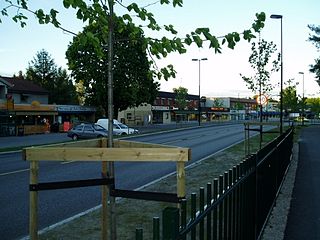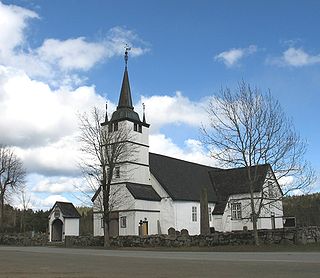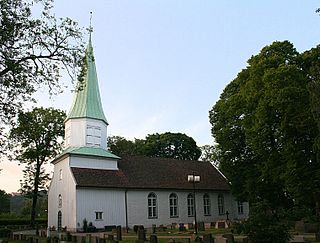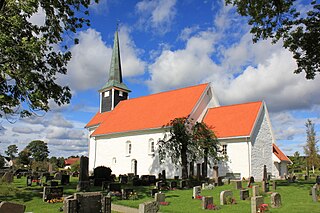
Trøgstad was a municipality in Østfold county, Norway. The administrative centre of the municipality was the village of Skjønhaug. The municipality included the parishes of Skjønhaug, Havnås and Båstad. The parish of Trygstad was established as a municipality on 1 January 1838.

Råde is a municipality in Østfold county, Norway. The administrative centre of the municipality is the village of Karlshus. The parish of Raade was established as a municipality on 1 January 1838.

Våler is a municipality in Østfold county, Norway. The administrative centre of the municipality is Kirkebygden. The parish of Vaaler was established as a municipality on 1 January 1838.

Nesodden is a municipality in Akershus in Akershus county, Norway. It is part of the Greater Oslo Region and many residents of the peninsula Nesodden commute to work in Oslo.

Fet was a municipality in Akershus county, Norway. It was part of the Romerike traditional region. The administrative centre of the municipality is the village of Fetsund.

Hole is a municipality in Buskerud county, Norway. It is part of the traditional region of Ringerike. The administrative centre of the municipality is the village of Vik. Hole is located around lake Tyrifjorden and extends to the woodland around Oslo. The soil is fertile and suited to growing fruit, berries and other agricultural products.

Marker is a municipality in Østfold county, Norway. The administrative centre of the municipality is the village of Ørje. Marker was created as a new municipality on 1 January 1964 following the merger of the two former municipalities of Rødenes and Øymark.

Vågå Church is a historic stave church. It is a parish church of the Church of Norway in Vågå Municipality in Innlandet county, Norway. It is located in the village of Vågåmo. It is the church for the Vågå parish which is part of the Nord-Gudbrandsdal prosti (deanery) in the Diocese of Hamar. The brown, wooden church was built in a cruciform design in 1627 by the architect Werner Olsen. The church seats about 250 people.

Røldal Stave Church is a parish church of the Church of Norway in Ullensvang Municipality in Vestland county, Norway. It is located in the village of Røldal. It is the church for the Røldal parish which is part of the Hardanger og Voss prosti (deanery) in the Diocese of Bjørgvin. The brown, wooden stave church was built in around the year 1250 using designs by an unknown architect. The church seats about 130 people and is built in a long church design. The church is a preserved historic museum, but it is still a regularly-used parish church that holds regularly scheduled worship services twice a month.

Kråkstad is a village and former municipality located in Nordre Follo municipality in Akershus, Norway.

Ytre Enebakk is a village and a forest and farming village in the municipality Enebakk in Akershus. The village has 3,359 inhabitants as of 1 January 2009, and is located 10 kilometers southwest of the municipal center of Kirkebygda and 30 kilometers from Oslo, Norway's capital. Ytre Enebakk is surrounded by low wooded hills and many small lakes

Ramnes is a village in Tønsberg Municipality in Vestfold county, Norway. The village is located about 12 kilometres (7.5 mi) to the northwest of the city of Tønsberg, about 3.5 kilometres (2.2 mi) to the northwest of the village of Linnestad, about 2.5 kilometres (1.6 mi) to the southwest of the villages of Bergsåsen/Revetal, and about 7.5 kilometres (4.7 mi) to the south of the village of Fon.

Høvåg is a former municipality in the old Aust-Agder county in Norway. The 77 km2 (30 sq mi) municipality existed from 1865 until its dissolution in 1962. It was located in the southern part of the present-day municipality of Lillesand which is now in Agder county. The administrative centre of the municipality was the village of Høvåg where the Høvåg Church is located. Old coastal settlements in Høvåg include Ulvøysund, Gamle Hellesund, Skottevik, Kjøbmannsvig and Åkerøyhamn. The village of Høvåg is located midway between the towns of Lillesand and Kristiansand.

Holt is a former municipality in the old Aust-Agder county in Norway. The 176-square-kilometre (68 sq mi) municipality existed from 1838 until its dissolution in 1960 when it was merged into the present-day municipality of Tvedestrand which is now in Agder county. The administrative centre of Holt was located just south of the village of Fiane where Holt Church is located.

Øyestad is a former municipality in the old Aust-Agder county in Norway. The 96-square-kilometre (37 sq mi) municipality existed from 1838 until 1992 when it was merged into the present-day municipality of Arendal which is now located in Agder county. At the time of its dissolution, the municipality of Øyestad encompassed most of the coastline between the towns of Grimstad and Arendal, along with the forested areas along the Nidelva river heading inland. Back in 1838, however, the municipality was far larger in size. The administrative centre was the village of Bjorbekk near the Bjorbekk Church.

Vår Frue Church is a medieval parish church of the Church of Norway in Trondheim municipality in Trøndelag county, Norway. It is located in the downtown Midtbyen area of the city of Trondheim, just a few blocks north of the Nidaros Cathedral. It is one of the two churches for the Nidaros og Vår Frue parish which is part of the Nidaros domprosti (arch-deanery) in the Diocese of Nidaros. The gray, stone church was built in a long church design in the late 1100s using plans drawn up by Bjørn Sigvardsson. The church seats about 540 people.

Alstadhaug Church is a parish church of the Church of Norway in the village of Alstadhaug, in Levanger municipality in Trøndelag county. It is the church for the Alstadhaug parish, which is part of the Stiklestad prosti (deanery) in the Diocese of Nidaros. The church was built in a long church style during the 12th century by an unknown architect. The church seats about 238 people.

Oddernes Church is a parish church of the Church of Norway in Kristiansand Municipality in Agder county, Norway. It is located in the district of Lund in the borough of Lund in the city of Kristiansand. It is one of the churches for the Oddernes parish which is part of the Kristiansand domprosti (arch-deanery) in the Diocese of Agder og Telemark. The white, stone church was built in a long church design around the year 1040 using plans drawn up by unknown architect. This makes it the oldest building in the city of Kristiansand. The church seats about 395 people.

Enebakk Church is a rectangular church dating from the 1100s or 1200s in the municipality of Enebakk in Akershus county, Norway. Construction of today's church started around 1100 and since then it has undergone both expansions and major restorations, most recently in 2010.

Kodal Church is a parish church of the Church of Norway in Sandefjord Municipality in Vestfold county, Norway. It is located in the village of Kodal. It is the church for the Kodal parish which is part of the Sandefjord prosti (deanery) in the Diocese of Tunsberg. The white, stone church was built in a long church design around the year 1100 using plans drawn up by an unknown architect. The church seats about 225 people.



























